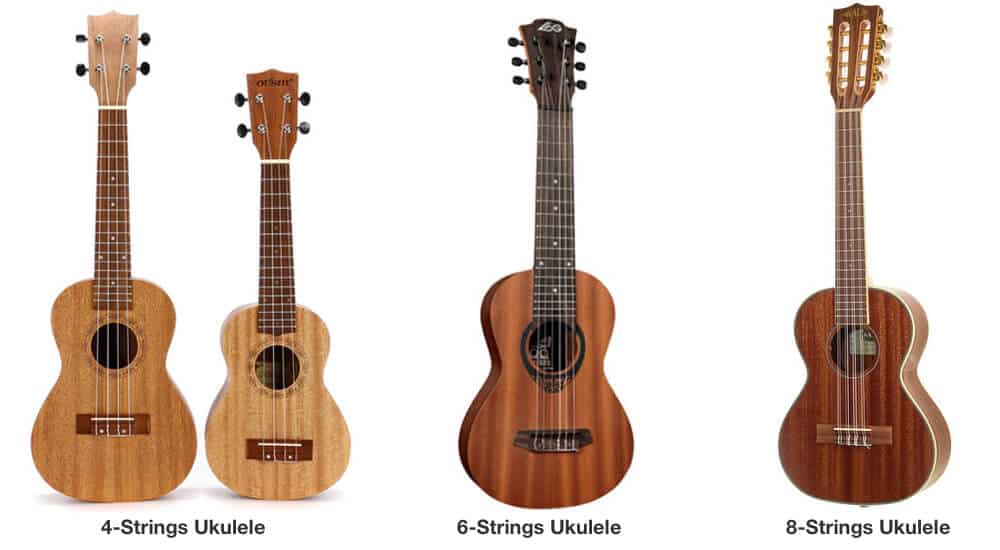Ukulele Strings and How to Tune them
One of the first things you need to learn when taking ukulele lessons is learn about ukulele strings and how to tune your ukulele. Ukulele tuning is really necessary if you want it to sound good. In this article, we will give you some information about ukulele strings and guide to tune them accurately
How Many Strings Does a Ukulele Have?
A standard ukulele has four strings. However, there are also variations of the ukulele with six, eight, or even more strings, which are known as six-string, eight-string, or tenor ukuleles, respectively. Nevertheless, the four-string ukulele is the most common and widely used among beginners and professionals alike.

Materials of Ukulele String
The sound of a ukulele varies depending on its string material. This can make shopping for new strings slightly overwhelming, but fortunately most players will only have to choose from a few key string styles.
Nylon strings
These are the most common type of ukulele strings and are usually made of a monofilament nylon. They produce a warm and mellow sound and are easy on the fingers.s.
Fluorocarbon strings
These strings are made of a denser material than nylon and produce a brighter and clearer sound. They are also more durable and have better intonation than nylon strings
Steel strings
Some ukuleles can be strung with steel strings, which produce a brighter and louder sound than nylon or fluorocarbon strings. However, steel strings can be harder on the fingers and may require adjustments to the ukulele's setup.
Wound nylon strings
In some ways, wound nylon strings split the difference between traditional nylon and bright steel. These strings have a nylon core that is wrapped with a thin polymer thread. They have a somewhat richer sound than standard strings and are most common on baritone or tenor ukuleles.
Wound metal strings
These strings are similar to wound nylon strings, but with a metal core. They get about as bright as you can without crossing over to steel strings—which may make your ukulele sound more like a guitar.
How Long Are Ukulele Strings?
The length of a ukulele’s strings varies depending upon the size of the ukulele. Two numbers matter when selecting strings: the total length and the scale length, which is the distance from the nut to the bridge, or the actual length of string that vibrates when you pluck or strum it.

What Is Standard Tuning for a Ukulele?
For most concert, soprano, and tenor ukulele players, G-C-E-A tuning is typical. With G being the lowest pitch string and A being the highest pitch string. Here are some steps to tune a ukulele.
- The fourth string. Tune this bottom string to G4. Typically, this string is called the G string. Some players call this string "low G," but it is actually the second-highest pitch of all the strings.
- The third string. Tune the next string up is to C4. Sometimes called the C string, the third string has the lowest pitch of the strings.
- The second string. Tune this string to E4. Also known as the E string, it has the second-lowest pitch of the strings.
- The first string. Tune this top string to A4. Called the A string, it has the highest pitch of the strings.
Remember that these strings don't progress from lowest to highest pitch. The lowest pitch is really produced by the third string. This type of ukulele tuning is known as reentrant tuning, as opposed to the linear tuning found on other stringed instruments.

How to Tune Ukulele Strings
Tuning a ukulele is similar to tuning a guitar, but with only four strings and different tuning. You can tighten and loosen ukulele strings by turning the tuning pegs on the instrument's headstock. Most players use electronic devices to assist their ukulele tuning. These includes:
1. Using a piano or another instrument
If you have access to a piano or another instrument that is already in tune, you can use it as a reference pitch. Play the reference note on the piano and then match the sound of each string to the reference pitch.
2. Electronic tuner
Electronic tuners attach to a ukulele headstock and measure vibrations in the actual wood of the instrument. You can use electronic tuners with any type of ukulele, whether or not it has a pickup.
3. Tuning apps
This is the easiest and most accurate way to tune your ukulele. Your phone relies on its external microphone to pick up the sound of your instrument, and other ambient sounds can interfere with its reading. Still, a tuner app on your phone is quite handy as a backup. Our Guitar Tunio app offers a powerful ukulele tuner that helps you tune your ukulele fast and accurately. The Guitar Tuner is available for both Android and iOS smartphones, click here to download the app

4. Using your ears
If you have a good sense of pitch, you can tune your ukulele by ear. Start by tuning the G string to a reference pitch, and then use it to tune the other strings. Pluck the G string and then press the third fret to produce the sound of the C string. Adjust the tuning peg of the C string until the sound matches the G string's third fret. Then, press the fourth fret of the C string to produce the sound of the E string and adjust its tuning peg. Finally, press the second fret of the G string to produce the sound of the A string and adjust its tuning peg.








